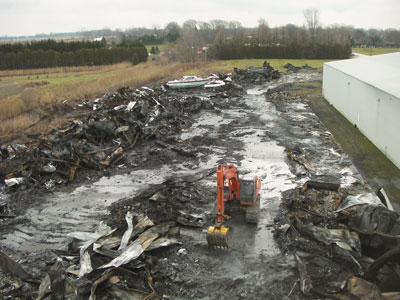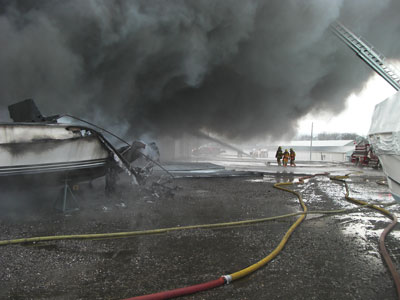
Features
Hot topics
Incident reports
A cohesive attack
It is generally understood that emergency services will plan, prepare and train for the big one, while it is expected that these plans will rarely be tested.
September 6, 2012
By Steve Bicum
It is generally understood that emergency services will plan, prepare and train for the big one, while it is expected that these plans will rarely be tested. On Dec. 20, 2011, the plans and preparation were tested in the Township of St. Clair in Ontario.
 |
|
| A fire in December 2011 caused $50 million in damages to a boat-storage warehouse in St. Clair Township, Ont., and tested the community’s emergency planning. Photos courtesy St. Clair Township Fire Department
|
Background
The Township of St. Clair is a diverse community covering 1,000 square kilometres, (400 square miles), located about an hour west of London and an hour north of Windsor. It shares a 32-kilometre border with the United States. The 15,000 residents live in small urban centres and small family farms dot the township.
The St. Clair Township Fire Department is composed of 180 volunteer firefighters in six fire stations with a full-time chief and two deputy chiefs. The department maintains 19 frontline apparatuses along with several support vehicles, and covers the entire gamut of fire protection, from small rural farms with no water supply, to developed urban areas with many commercial and residential complexes, to heavy oil refineries producing various fuels and plastics.
The situation
These resources were put to the test that December morning. An employee of St. Clair Marine and Boating entered the 2,800-square-metre (30,000-square-foot) boat storage warehouse at around 0700 to do some work on one of about 80 boats. Shortly after entering warehouse, the employee heard a noise that turned out to be a fire on the top of an 11-metre (35-foot) yacht. The employee exited the building and ran down the street to find a phone.
 |
|
| The fire flattened the warehouse but crews were able to control the blaze and save an adjacent building.
|
At 0713 Port Lambton Station was dispatched, responding with a 5,000-litre-per-minute (L/min.) pump, a tanker and a rescue. Following protocol, the Becher Station was dispatched with a 6,000 L/min. pump, a tanker and a rescue. While responding, Fire Chief Roy Dewhirst could see heavy smoke from 20 kilometres away and immediately ordered the Wilkesport Station to respond with another 6,000 L/min. pump, tanker and rescue.
Chief Dewhirst also activated the Brigden Station and shifted resources to provide coverage protection, since the incident was in the extreme south of the township and was pulling all southern stations out of position.
Port Lambton Station arrived on scene at 0722 to thick, black smoke issuing from a large overhead door that had been blown off its tracks. An area of about 24 square metres (250 square feet) just inside the only access to the building was fully involved. The initial defensive attack was set up, with two hand lines and the deck gun from the pumper drawing from a 2,000 L/min. hydrant.
As Port Lambton Station continued to develop the defensive attack, I arrived on scene and activated the Corunna Station to respond with the 23-metre (75-foot) telesquirt. Wilkesport, Becher and the 5,000 L/min. reserve pumper arrived and began drafting operations in a waterway across the street from the building. Several hand lines and six 3,000-L/min. ground monitors were set up in an attempt to suppress the fire and protect the second 2,800-square-metre (30,000-square-foot) boat warehouse just four metres away from the fire. Additional resources continued to arrive including OPP, EMS and public works.
At about 0800, Chief Dewhirst was contacted by the fire chief of Algonac, Mich., just across the river from the incident, who asked if his department could offer assistance. The offer was accepted, and Clay Township, Ira Township, and the Town of Algonac activated their resources and dispatched a fire boat with an 8,000-L/min. (2,000-gpm) pump, and later sent a 23-metre (75-foot) platform aerial device. The platform crossed the border on the Bluewater Ferry, which was alerted to the situation and expedited the crossing. Canadian border officials, who were made aware of the situation, did not delay the unit.
The defensive attack continued for hours. By 1200, there were 90 firefighters on scene with four pumpers, three tankers, three rescues, one fire boat, two aerial devices and six support vehicles. In addition, several OPP vehicles controlled access to the area, one ambulance was on standby, and one command unit and several public works vehicles with 10 employees remained on scene.
The large number of personnel and equipment was a challenge for the accountability officer, but a new card system put in place four years ago aided in the management of personnel and equipment. The new accountability system includes tags with firefighters’ names and pictures on them and truck tags that have key resource information for each apparatus. Both systems assisted accountability with managing so many resources.
The issues
There were several issues identified both during the incident and from the post-incident review.
- Environmental risk. Deputy Chief Tom Boon notified the Ministry of the Environment at around 0900 and liaised with a representative for the remainder of the incident. The thick, heavy, black smoke, although copious, luckily carried over the 100 residences directly adjacent to the area and dispersed over the United States. A shelter-in-place advisory was issued to residents and the OPP encouraged people to stay away if possible. The more immediate threat to the environment was the run-off being generated by the suppression efforts. It was fortunate that the incident was located across the street from the St. Clair River, and with the assistance of public works, loads of sand and clay were quickly brought on scene to seal ditches and drains to the river. Public works also brought in a vac truck to draw off ash and debris that settled on the water’s surface. The biggest containment issue was a small creek that ran seven metres (20 feet) behind the building. Again, with the assistance of public works, the fire department quickly set up a makeshift containment boom across the creek. A private environmental response company was contacted and quickly arrived on scene to take over containment efforts.
- Access. The fire building was located behind the other boat warehouse, and was 60 metres (200 feet) from the street. There was a small driveway and parking area on the west end of the building where the initial trucks set up, but this area was down wind, ringed with boats, and sometimes engulfed in smoke. This meant that long runs of large-diameter hose had to be set out by personnel through mud and standing water. During the early stages of the incident, efforts were made to try to cut off the fire’s advance. However, the fire started just inside the main access door, and the several small doors on the side of the building were secured from the inside with deadbolts and bars, hindering efforts to enter the building. Once the doors were breeched, a further problem was discovered: the boats, most of which were large yachts – 12 metres long, six metres high and stored on steel stands – were packed in like sardines. At no point could fire streams get past the perimeter and penetrate the seat of the fire. This meant the fire continued to progress down the length of the building until it was fully involved.
- Accountability. Accountability within the fire department worked well, but the size of the incident was a challenge. Accountability was set up at the command post at one end of the building. Teams would have to walk long distances to get around the buildings and often teams were switched out and there were delays updating the board. This was unique to this event, but highlighted the issue should there be another large-scale event. The real problem was trying to account for non-fire personnel. OPP, EMS and public works do not operate with accountability tags, so keeping track of them was an extreme challenge and is something the fire department will address.
- Air supply. This was a defensive attack but the nature of the fire meant that many of the firefighters had to remain on air. There were 47 SCBAs on scene with 94 spare bottles. Even with that, 210 refills had to be done, which meant a crew had to transport the bottles 35 kilometres to our filling station and back. This increased the risk to crews and has resulted in council’s approval of the purchase of a mobile filling system.
The results
After battling the fire for 18 hours, and with the assistance of two excavators, the blaze was extinguished. Once the smoke cleared, some 80 boats had been consumed at a cost of about $50 million. The estimated fuel load was 725 tonnes (800 tons) of material plus 69,000 litres (18,000 gallons) of fuel. More than eight million litres (two million gallons) of water were pumped.
 |
|
| Crews spent 18 hours fighting the massive blaze at a boat-storage warehouse. Within five hours of dispatch, 90 firefighters were on scene with four pumpers, three tankers, three rescues, one fire boat, two aerial devices and six support vehicles.
|
As a result of the incident, the fire department is analyzing building access, interior storage procedures and pre-planning of the three remaining storage buildings.
For several years, the department has made a concerted effort to ensure that all six fire stations could operate together under the incident management system (IMS), but fire administration didn’t think that this co-operation would be put to such a test. All personnel were able to operate equipment from different stations and work with different personnel under a single incident commander. This IMS approach extended to the other emergency services, the American firefighters, public works, and the other groups and organizations involved. Strengthening the department’s relationships with these groups to ensure clear and open lines of communication, a greater understanding of operational procedures and scene accountability remains a priority.
Despite the large loss, this situation could have escalated to $100 million had the second building not been protected. The fact that there was zero damage to the exposure was due to the concerted efforts of all personnel on scene.
“This was a once-in-a-career fire,” Chief Dewhirst said. In a career that has covered 40 years, we certainly hope he is correct.
Results of the investigation by the Office of the Ontario Fire Marshal were pending at press time.
Steven Bicum is the deputy fire chief (co-ordinator of training and safety) with the St. Clair Township Fire Department. He began his career as a volunteer with the Wilkesport Station, where he was training officer, captain and fire prevention officer. He has been chair of Lambton County Fire Prevention Association, vice-president of the Lambton-Kent Firefighter Association, and an adjunct faculty member at the Lambton College Fire Emergency Response Training Centre. He is an associate instructor for the Ontario Fire College. Bicum has deep roots in St. Clair Township: his children are the fifth generation to live on their family farm. Contact him at sbicum@twp.stclair.on.ca
Print this page